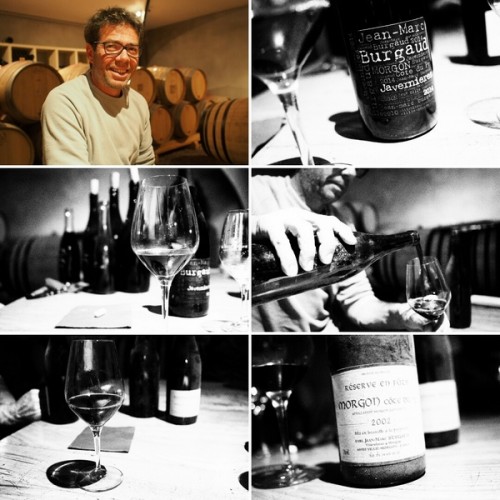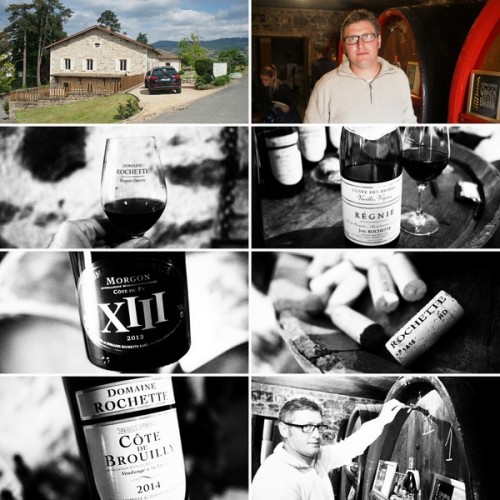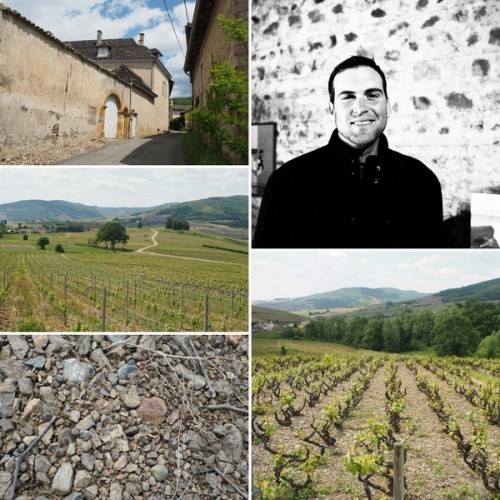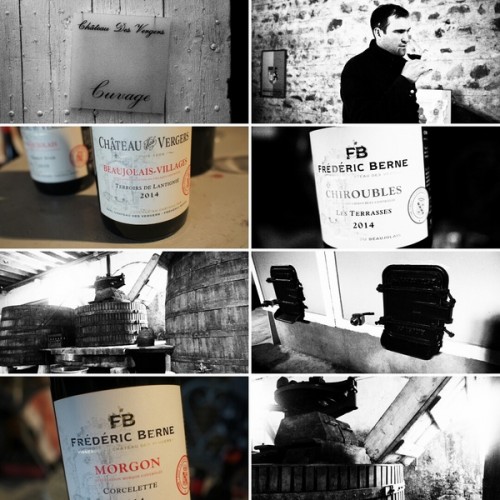
Jean-Marc Burgaud is based in Villié-Morgon, in the heart of the most celebrated of the crus. We had a beautiful early evening visit here that had an energy of its own. It’s so interesting following the dynamics of producer visits. Often they don’t really know who you are (many producers are so busy making their wines they simply haven’t got time to track the journalist scene), and you don’t know much about them. So there’s an initial reticence to the encounter, and depending on the personal chemistry, the visit can then find energy, or it can be a bit of a struggle. If the wines are good, they usually carry the visit beautifully: your response as you taste the wines is usually picked up pretty clearly by the winegrower.
With Burgaud, everything clicked. We had such a good time. He’s been making wine since 1989, when he started with just 3 hectares. In 1992 he got his first holdings on Côte du Py, the most celebrated of the Morgon terroirs, and now he is working with 17.5 hectres, including 8 hectares in Côte du Py.
Burgaud’s wines are quite structured and yet they avoid being overpowering or too extracted. He works in quite a reductive way, and young these wines can show a bit of matchstick/mineral/spice reduction, but this sets them up nicely for some ageing. I really loved his 2014s, which show a sense of place. The Côte du Py Javernières, which has the most alluvial soils in this climat, is sensational, as is the special bottling called ‘James’, which is from the top of the south side.
It was really interesting to try the 2015, which is an atypical vintage in the region because of the heat and dryness, and which has resulted in powerful, structured wines that tend to be a bit on the big side if the winemaking was handled sensitively. 2015 is being widely heralded by most of the growers as the best they have seen, because despite the ripeness they also had good natural acidity. But winemaking wasn’t easy: many winegrowers have found it hard to get the fermentations to complete, and have had to delay taking the wine out of tank or barrel for blending and bottling. Burgaud’s 15s are looking very good indeed, but it’s early days.
We did a vertical of the Côte de Py, looking at 2010 (beautiful), 2008 (a weaker year), 2005 (tannic but pretty), 2002 (just lovely) and 1995 (sensational). We finished with a bottle of 1964 (not Jean-Marc’s), but he was disappointed it wasn’t showing as well as he’d hoped. Still, a lovely way to end a really lovely visit.

Domaine Rochette is a typical, solid, traditional Beaujolais producer based in Régnié. They’re a family domaine that began in the early 1980s, and we met with Matthieu Rochette who began working with his parents in 2009. They have 15 hectares altogether, including holdings in four crus. The wines here are consistently good, and particular highlights were the excellent Régnié Cuvée des Braves 2014 and 2015, and the Côte de Brouilly. The Morgon Côte du Py Special Selection is also really good. A real treat was the chance to try the Cuvée des Braves 2000, which had aged fabulously into an elegant maturity.

Next up was one of the highlights of the trip. It’s always great to make a new discovery, and I loved the winemaking of Frédéric Berne at Château Les Vergers in Lantignié. He’s a talented winegrower who works in a natural, terroir-transparent way, and he came here in 2005. In way of rent, he gives 50% of the wine to the Château and gets to use the rather rustic, ancient winery (including a gazillion-year old wooden press that looks like it belongs to a museum) and the vineyards. Berne did nine years working with Perraud, learning how to make traditional, conventional wines. Then he worked with the Bret Brothers at Domaine de Soufrandière in Mâcon, where he learned about biodynamics and natural winemaking. This changed everything. ‘I discovered a completely different side of winemaking,’ he says. He’d like to do what they have done for Mâcon for Beaujolais: revisiting the terroirs and making wines of a high level. To this end, he’s pressing for Lantignié to be recognized as a cru, in due time, because of its special soils. It has 312 hectares, and it would be great to see it on the label. His Beaujolais Villages Terroirs de Lantignié 2014 is supple, pale coloured and pure. The Chiroubles Les Terrasses comes from pink granite soils, and in 2014 it is thrilling with a bit of matchstick reduction offsetting the pure, precise fruit. And the Morgon Corcelette 2014 is superbly elegant, with a liqueur-like richness to the fruit with grippy tannin and high acidity, and it all works together perfectly. ‘People don’t understand Beaujolais,’ says Berne. ‘I want to differentiate the terroir and show what Beaujolais can do.’

Can I ask a question? I have some 2005 Burgaud Cote du Py in storage in a friend’s cellar. I’m minded to leave it there a few more years. Would this sound wise to you, having tried it?
I’m 18 1/2 months late, but in your title, it should be Rochette, not Roquette.
Where’s the exit ?
Thank you corrections always appreciated!